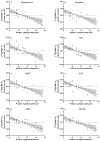Imaging Brain Fatty Acid Amide Hydrolase in Untreated Patients With Psychosis
- PMID: 32387132
- PMCID: PMC8240477
- DOI: 10.1016/j.biopsych.2020.03.003
Imaging Brain Fatty Acid Amide Hydrolase in Untreated Patients With Psychosis
Abstract
Background: The brain's endocannabinoid system, the primary target of cannabis, has been implicated in psychosis. The endocannabinoid anandamide is elevated in cerebrospinal fluid of patients with schizophrenia. Fatty acid amide hydrolase (FAAH) controls brain anandamide levels; however, it is unknown if FAAH is altered in vivo in psychosis or related to positive psychotic symptoms.
Methods: Twenty-seven patients with schizophrenia spectrum disorders and 36 healthy control subjects completed high-resolution positron emission tomography scans with the novel FAAH radioligand [11C]CURB and structural magnetic resonance imaging. Data were analyzed using the validated irreversible 2-tissue compartment model with a metabolite-corrected arterial input function.
Results: FAAH did not differ significantly between patients with psychotic disorders and healthy control subjects (F1,62.85 = 0.48, p = .49). In contrast, lower FAAH predicted greater positive psychotic symptom severity, with the strongest effect observed for the positive symptom dimension, which includes suspiciousness, delusions, unusual thought content, and hallucinations (F1,26.69 = 12.42, p = .002; Cohen's f = 0.42, large effect). Shorter duration of illness (F1,26.95 = 13.78, p = .001; Cohen's f = 0.39, medium to large effect) and duration of untreated psychosis predicted lower FAAH (F1,26.95 = 6.03, p = .021, Cohen's f = 0.27, medium effect). These results were not explained by past cannabis exposure or current intake of antipsychotic medications. FAAH exhibited marked differences across brain regions (F7,112.62 = 175.85, p < 1 × 10-56; Cohen's f > 1). Overall, FAAH was higher in female subjects than in male subjects (F1,62.84 = 10.05, p = .002; Cohen's f = 0.37).
Conclusions: This first study of brain FAAH in psychosis indicates that FAAH may represent a biomarker of disease state of potential utility for clinical studies targeting psychotic symptoms or as a novel target for interventions to treat psychotic symptoms.
Keywords: Endocannabinoid; Fatty acid amide hydrolase; Imaging; Positron emission tomography; Psychosis; Schizophrenia.
Copyright © 2020 Society of Biological Psychiatry. Published by Elsevier Inc. All rights reserved.
Figures



Comment in
-
Alterations in the Endocannabinoid System in Schizophrenia.Biol Psychiatry. 2020 Nov 1;88(9):675-677. doi: 10.1016/j.biopsych.2020.08.019. Biol Psychiatry. 2020. PMID: 33032694 No abstract available.
References
-
- Fernandez-Espejo E, Viveros M-P, Núñez L, Ellenbroek BA, Rodriguez de Fonseca F (2009): Role of cannabis and endocannabinoids in the genesis of schizophrenia. Psychopharmacology. 206:531–549. - PubMed
-
- Mechoulam R, Parker LA (2013): The endocannabinoid system and the brain. Annual review of psychology. 64:21–47. - PubMed
-
- Cravatt BF, Demarest K, Patricelli MP, Bracey MH, Giang DK, Martin BR, et al. (2001): Supersensitivity to anandamide and enhanced endogenous cannabinoid signaling in mice lacking fatty acid amide hydrolase. Proceedings of the National Academy of Sciences of the United States of America. 98:9371–9376. - PMC - PubMed
-
- Romero J, Hillard CJ, Calero M, Rabano A (2002): Fatty acid amide hydrolase localization in the human central nervous system: an immunohistochemical study. Brain Res Mol Brain Res. 100:85–93. - PubMed
Publication types
MeSH terms
Substances
Grants and funding
LinkOut - more resources
Full Text Sources
Other Literature Sources
Medical
Miscellaneous

